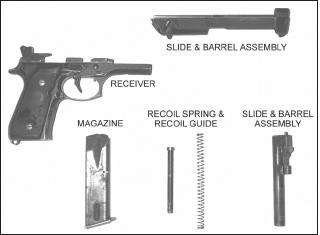Department of the Army
U.S. ARMY COMBAT PISTOL TRAINING HANDBOOK
This publication applies to the Active Army, the Army National Guard (ARNG), the National Guard of the United States (ARNGUS), and the US Army Reserve (USAR). It provides guidance on the operation and marksmanship of the M9, 9-mm pistol and the M11, 9-mm pistol. It reflects current Army standards in weapons qualification. It is a guide for the instructor to develop training programs, plans, and lessons that meet the objectives of the US Army Marksmanship program for developing combat-effective marksmen. The Soldier develops confidence, knowledge, and skills by following the guidelines in this manual.
The proponent of this publication is the US Army Infantry School. Send comments and recommendations on DA Form 2028 directly to Commandant, U.S. Army Infantry School, ATTN: ATSH-ATD, Fort Benning, GA 31905, or by email to [email protected].
Unless this publication states otherwise, masculine nouns and pronouns refer to either gender.
CHAPTER 1
SECTION I. DESCRIPTION AND COMPONENTS
The M9 (Figure 1-1) and M11 (Figure 1-2) pistols are 9-mm, semiautomatic, magazine-fed, recoil- operation, double-action weapons chambered for the 9-mm cartridge.


1-1. Description
Table 1-1 summarizes equipment data for both pistols.

NOTE: For additional information on technical aspects of the M9 pistol, see TM 9-1005 -317-10. For additional information on technical aspects of the M11 pistol, see TM 9-1005-325-10.
1-2. Components
The major components of the M9 (Figure 1-3) and M11 (Figure 1-4) pistols are:
a. Slide and Barrel Assembly: Houses the firing pin, striker, and extractor. Cocks the hammer during recoil cycle.
b. Recoil Spring and Recoil Spring Guide: Absorbs recoil and returns the slide assembly to its forward position.
c. Barrel and Locking Block Assembly: Houses cartridge for firing, directs projectile, and locks barrel in position during firing.
d. Receiver: Serves as a support for all the major components. Houses action of the pistol through four major components. Controls functioning of the pistol.
e. Magazine: Holds cartridges in place for stripping and chambering.


1-3. Ammunition
M9 and M11 pistols use several different types of 9-mm ammunition. Soldiers should use only authorized ammunition that is manufactured to US and NATO specifications.
a. Type and Characteristics. The specific type ammunition (Figure 1-5) and its characteristics are as follows:
(1) Cartridge, 9-mm ball, M882 with/without cannelure.
(2) Cartridge, 9-mm dummy, M917.

b. Care, Handling, and Preservation.
(1) Protect ammunition from mud, sand, and water. If the ammunition gets wet or dirty, wipe it off at once with a clean dry cloth. Wipe off light corrosion as soon as it is discovered. Turn in heavily corroded cartridges.
(2) Do not expose ammunition to the direct rays of the sun. If the powder is hot, excessive pressure may develop when the pistol is fired.
(3) Do not oil or grease ammunition. Dust and other abrasives that collect on greasy ammunition may

